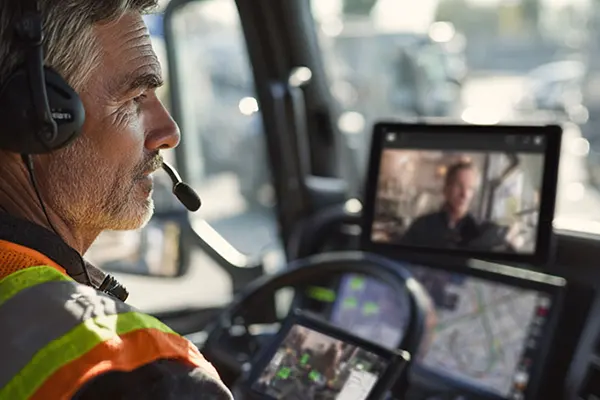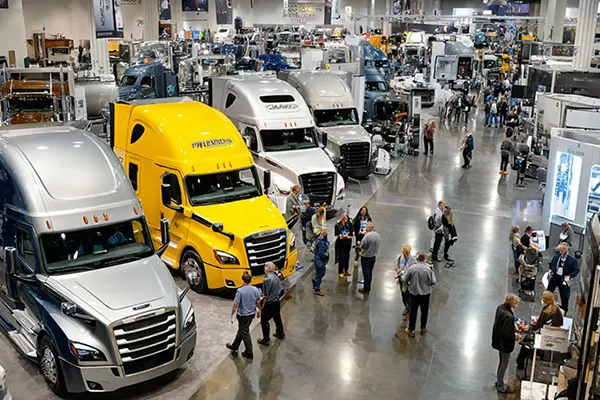
Improving Communication Between Truck Drivers and Dispatchers with Modern Tools
Why Communication Between Drivers and Dispatchers Matters
What is driver-dispatcher communication?
Driver-dispatcher communication is the real-time, bidirectional flow of information between commercial drivers and dispatchers. This includes updates on delivery status, changes in routing, equipment issues, traffic delays, and safety concerns. It serves as the central nervous system of any fleet operation.
Why It’s Critical
Effective communication ensures:
- Operational efficiency ¾ Faster, smarter routing reduces idle time and optimizes resource allocation.
- Driver safety ¾ Immediate updates on road conditions or mechanical issues help prevent accidents.
- Customer satisfaction ¾ Clear ETAs and proactive notifications create transparency and trust.
A 2024 survey by FleetOwner showed that companies with integrated communication platforms experienced 23% fewer missed deliveries compared to those using traditional methods.
Consequences of Poor Communication
When communication breaks down, the ripple effects can be costly:
- Delayed or failed deliveries.
- Increased fuel consumption from inefficient routing.
- Frustrated drivers and dispatchers due to unclear expectations.
- Compromised safety from unreported vehicle issues or last-minute route changes.
Even minor miscommunications can result in lost revenue, regulatory penalties, and diminished brand reputation.
Industries That Rely Heavily on This Communication
This isn’t just a trucking issue. The need for precise, timely communication spans multiple industries:
- Logistics and freight: Real-time tracking and coordination are mission-critical.
- E-commerce and delivery services: High-volume, time-sensitive deliveries require agile dispatching.
- Construction fleets: Equipment deliveries must align precisely with project timelines.
- Field service operations: Technicians and contractors depend on accurate job details and updates.
Top Communication Challenges in Traditional Dispatching
While communication is vital to fleet operations, many companies still rely on outdated, fragmented systems that fail to support the demands of real-time logistics. These legacy methods often create inefficiencies, increase risk, and undermine operational goals.
1. Outdated Communication Methods
Many fleets continue to depend on phone calls, CB radios, or even handwritten notes. These methods lack the clarity and traceability needed for effective coordination.
- Information can be misheard, forgotten, or relayed inaccurately.
- There’s no written record of what was communicated or when.
- Real-time updates are difficult to capture or distribute consistently.
For example, if a dispatcher gives a driver a new delivery address over the phone and the driver miswrites it, the result could be a costly delivery error.
2. Lack of Real-Time Visibility
When dispatchers cannot see where drivers are or what obstacles they’re facing, they’re left guessing.
- Delays caused by traffic, construction, or vehicle issues go unreported until it’s too late.
- Dispatchers are forced to react rather than plan proactively.
- Route changes or job updates may not reach drivers in time.
This lack of situational awareness contributes to inefficiencies and misalignment between field and office operations.
3. Communication Silos Across Systems
In many operations, communication happens across disconnected tools: a routing system here, a messaging app there, and manual logs somewhere else.
- Information is scattered, inconsistent, and often incomplete.
- Dispatchers and drivers waste time jumping between platforms.
- Important updates can be delayed or missed entirely.
These silos create friction in daily workflows and limit opportunities for optimization.
4. No Communication Traceability
Traditional methods don’t capture or store messages in a way that can be audited or reviewed later.
- There is no central communication log.
- If a conflict or compliance issue arises, there’s no way to verify who said what or when.
- This lack of accountability can lead to misunderstandings and disputes, both internally and with customers.
5. Difficulty Prioritizing Urgent Information
Without a clear system for categorizing or flagging messages, dispatchers and drivers may struggle to identify what needs immediate attention.
- Critical updates may be buried in routine chatter.
- Drivers might miss safety instructions or high-priority changes due to information overload.
- Dispatchers must spend extra time repeating or clarifying messages.
Over time, this can erode trust and increase the risk of costly mistakes.
Modern Tools That Bridge the Communication Gap
Modern fleet operations demand tools that offer speed, traceability, integration, and ease of use. Today’s technologies are built not just to send messages, but to support smarter, safer, and more efficient decision-making between drivers and dispatchers.
Below are the leading communication tools that address the limitations of traditional systems.
1. GPS Fleet Tracking Systems
What it is:
GPS fleet tracking systems monitor vehicle locations in real time and feed that data back to dispatchers through a centralized platform.
How it helps:
- Offers instant visibility into driver location and movement.
- Allows dispatchers to provide accurate ETAs and respond to delays proactively.
- Enables route optimization based on traffic, weather, or road conditions.
Example tools: Verizon Connect, Samsara, Geotab
GPS fleet tracking provides real-time location data to help dispatchers manage routes and communicate effectively with drivers.
2. Mobile Dispatching Apps
What it is:
These apps allow dispatchers to assign jobs, share instructions, and communicate with drivers directly through mobile devices.
How it helps:
- Replaces phone calls and paper instructions with clear, logged digital communication.
- Enables two-way messaging with read receipts.
- Streamlines job scheduling, proof of delivery, and status updates.
Example tools: Motive (formerly KeepTruckin), Fleet Complete, Trucker Tools
Why it matters: Drivers receive updates on the go, reducing delays and misunderstandings while keeping their focus on the road.
3. ELDs and Telematics Platforms
What it is:
Electronic Logging Devices (ELDs) and telematics platforms automatically record vehicle activity, driver hours, engine diagnostics, and safety data.
How it helps:
- Eliminates manual logging and reduces reporting errors.
- Flags mechanical issues early, enabling proactive maintenance coordination.
- Supports compliance with DOT regulations and internal safety standards.
Example tools: Omnitracs, Zonar, JJ Keller
This type of automation reduces the back and forth between drivers and dispatchers over compliance questions or status updates.
4. Cloud-Based Communication Hubs
What it is:
These platforms unify messaging, GPS data, task management, and reporting into a single interface.
How it helps:
- Breaks down communication silos across departments.
- Makes all relevant information accessible in one place.
- Improves internal coordination and customer response times.
Example tools: Trimble TMS, Transflo, Fleetio
With centralized communication, nothing gets lost between systems or personnel.
5. AI-Driven Assistants and Automation
What it is:
Artificial intelligence tools can automate routine updates and flag operational issues before they escalate.
How it helps:
- Sends automated ETAs to customers and dispatchers.
- Identifies patterns of late departures, idle time, or missed stops.
- Reduces dispatcher workload by handling repetitive queries.
Example use: AI assistant notifies the dispatcher if a driver is behind schedule and suggests alternate routes in real time.
How to Choose the Right Tool for Your Fleet
With dozens of platforms promising better communication, it’s important to select a solution that aligns with your fleet’s size, workflows, and goals. The best tools are not necessarily the most complex — they’re the ones that solve your specific communication challenges and integrate smoothly into your daily operations.
Here’s how to evaluate your options effectively:
1. Identify Your Primary Communication Pain Points
Start by asking:
- Are drivers missing updates or job changes?
- Do dispatchers lack visibility into driver location or task status?
- Are compliance logs still being tracked manually?
- Is information spread across multiple apps or systems?
Clarifying your biggest issues will help you focus on tools that directly address those problems.
2. Prioritize Features That Fit Your Operation
Not every fleet needs every feature. Consider:
- Real-time GPS tracking for routing and ETA accuracy.
- Two-way messaging for driver-dispatch updates.
- Digital task assignments to replace manual workflows.
- Integration with ELDs or TMS systems for seamless data flow.
- Document and photo sharing for proof of delivery or incident reporting.
Choose functionality based on what actually improves your operational efficiency.
3. Ensure Mobile Accessibility and Driver Ease of Use
Drivers are the end users. If the tool is difficult to use, it won’t deliver value.
- Look for intuitive mobile apps with minimal training required.
- Choose platforms with voice support or automation features for safer use on the road.
- Avoid overly technical systems that slow down adoption.
A tool that drivers accept and trust is key to long-term success.
4. Check for Integration with Existing Systems
Make sure any additions will be compatible with your current systems, such as your:
- Fleet management software
- Routing or TMS platforms
- ELDs or safety monitoring tools
Make sure your new communication tool integrates smoothly with these systems. Avoid adding another silo that duplicates work or requires manual syncing.
5. Evaluate Support, Training, and Scalability
Even the best tool can fail without the right support:
- Ask about onboarding assistance, especially for drivers.
- Look for live support and easy-to-access documentation.
- Choose a platform that can scale as your fleet grows or diversifies.
6. Use a Pilot Program Before Full Deployment
Test the tool with a small team first:
- Monitor feedback from drivers and dispatchers.
- Track KPIs like response time, delivery accuracy, and compliance rates.
- Adjust configurations based on real-world use.
This approach ensures smoother adoption and fewer surprises during full rollout.
FAQ: Communication Tools for Truck Drivers and Dispatchers
What’s the easiest communication tool to implement for small fleets?
A mobile dispatching app with GPS tracking and in-app messaging is often the most accessible option. It requires minimal hardware and can be deployed quickly.
Are modern tools secure enough for sensitive fleet data?
Yes. Reputable platforms use end-to-end encryption, cloud backups, and role-based access controls to protect location, driver, and compliance data.
Can drivers use communication apps while driving?
Most platforms offer voice-enabled features or limit interaction while the vehicle is in motion to maintain safety and compliance with distracted driving laws.
How do I measure if a communication tool is improving performance?
Track changes in key metrics like dispatch response time, on-time delivery rate, idle hours, driver satisfaction, and customer complaints before and after implementation.
Please fill out the information below and our team will reach out to chat about your options.

